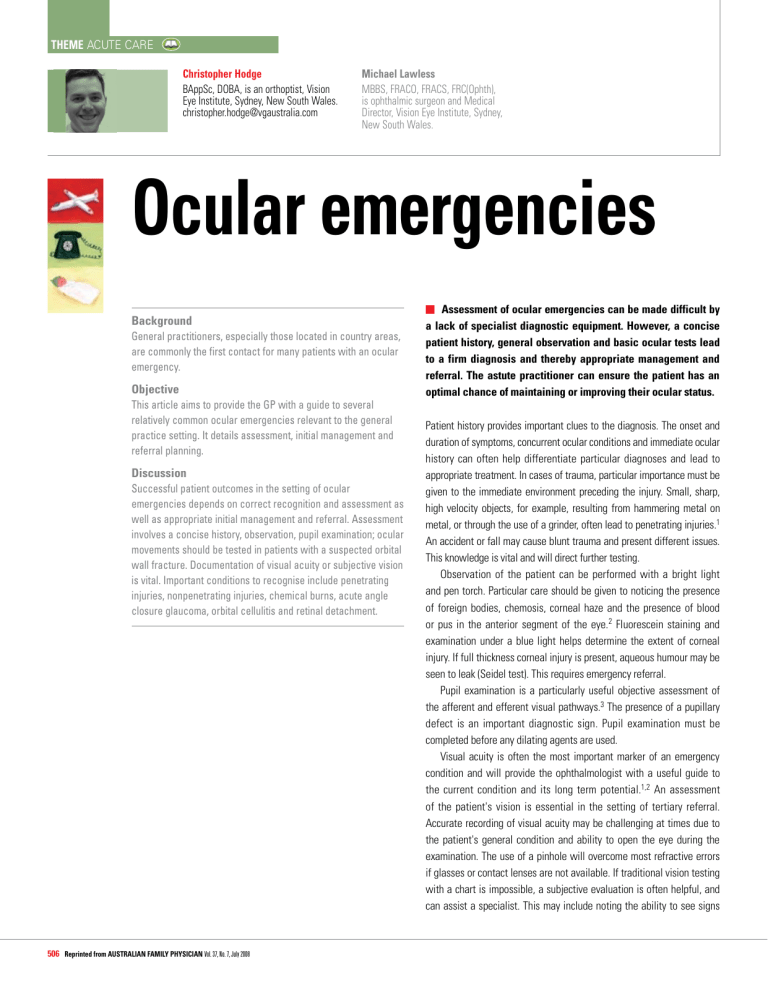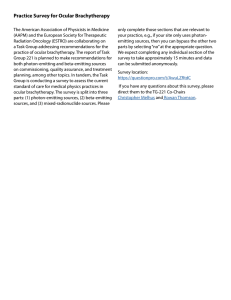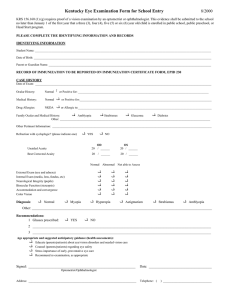
THEME ACUTE CARE Christopher Hodge BAppSc, DOBA, is an orthoptist, Vision Eye Institute, Sydney, New South Wales. christopher.hodge@vgaustralia.com Michael Lawless MBBS, FRACO, FRACS, FRC(Ophth), is ophthalmic surgeon and Medical Director, Vision Eye Institute, Sydney, New South Wales. Ocular emergencies Background General practitioners, especially those located in country areas, are commonly the first contact for many patients with an ocular emergency. Objective This article aims to provide the GP with a guide to several relatively common ocular emergencies relevant to the general practice setting. It details assessment, initial management and referral planning. Discussion Successful patient outcomes in the setting of ocular emergencies depends on correct recognition and assessment as well as appropriate initial management and referral. Assessment involves a concise history, observation, pupil examination; ocular movements should be tested in patients with a suspected orbital wall fracture. Documentation of visual acuity or subjective vision is vital. Important conditions to recognise include penetrating injuries, nonpenetrating injuries, chemical burns, acute angle closure glaucoma, orbital cellulitis and retinal detachment. 506 Reprinted from Australian Family Physician Vol. 37, No. 7, July 2008 Assessment of ocular emergencies can be made difficult by a lack of specialist diagnostic equipment. However, a concise patient history, general observation and basic ocular tests lead to a firm diagnosis and thereby appropriate management and referral. The astute practitioner can ensure the patient has an optimal chance of maintaining or improving their ocular status. Patient history provides important clues to the diagnosis. The onset and duration of symptoms, concurrent ocular conditions and immediate ocular history can often help differentiate particular diagnoses and lead to appropriate treatment. In cases of trauma, particular importance must be given to the immediate environment preceding the injury. Small, sharp, high velocity objects, for example, resulting from hammering metal on metal, or through the use of a grinder, often lead to penetrating injuries.1 An accident or fall may cause blunt trauma and present different issues. This knowledge is vital and will direct further testing. Observation of the patient can be performed with a bright light and pen torch. Particular care should be given to noticing the presence of foreign bodies, chemosis, corneal haze and the presence of blood or pus in the anterior segment of the eye.2 Fluorescein staining and examination under a blue light helps determine the extent of corneal injury. If full thickness corneal injury is present, aqueous humour may be seen to leak (Seidel test). This requires emergency referral. Pupil examination is a particularly useful objective assessment of the afferent and efferent visual pathways.3 The presence of a pupillary defect is an important diagnostic sign. Pupil examination must be completed before any dilating agents are used. Visual acuity is often the most important marker of an emergency condition and will provide the ophthalmologist with a useful guide to the current condition and its long term potential.1,2 An assessment of the patient's vision is essential in the setting of tertiary referral. Accurate recording of visual acuity may be challenging at times due to the patient's general condition and ability to open the eye during the examination. The use of a pinhole will overcome most refractive errors if glasses or contact lenses are not available. If traditional vision testing with a chart is impossible, a subjective evaluation is often helpful, and can assist a specialist. This may include noting the ability to see signs Figure 1. Iris extruding from a penetrating wound Figure 2. Hyphaema across the waiting room or the inability to count fingers or determine light perception at close range. Ocular movements are important in patients suspected of a fracture of the orbital wall to determine if muscles have been entrapped. Muscle restriction and diplopia should be noted. Examination may be difficult if swelling is present. Diagnosis may not be possible until this subsides. Penetrating ocular injuries Penetrating wounds, although rare, may be dramatic in presentation. The front of the eye (anterior chamber) may be flat in appearance; small bubbles may be present in the anterior chamber and the pupil may be irregular and nonreactive. The iris in severe cases may extrude from the wound (Figure 1). Although not specific to a penetrating injury, hyphaema and dislocation of the natural lens may also be seen. It is imperative that the eye is not touched or manipulated. If the object is present it should be left in situ as its removal may cause further herniation of the eye contents. Topical anaesthetic and antibiotics can be given to aid comfort and reduce the risk of infection. Nausea or vomiting should be suppressed with the use of antiemetics as violent head movements can aggravate the condition.2,4 Tetanus status should be confirmed and a booster dose given if required. The patient should be instructed not to eat or drink, as often surgery is required to repair the eye. It is important to advise the patient to attempt not to strain, cough, blow their nose or bend over before seeing a specialist. A pressure patch should be avoided, however a shield can be placed over the eye to provide protection. The bottom of a disposable cup is an adequate solution if eye shields are not available. Immediate referral to a hospital and/or specialist is essential. Nonpenetrating injuries Causes of blunt trauma to the eye include being hit with a cricket or squash ball, fist or surfboard. Examination can be difficult in the presence of lid oedema and care should be taken when examining the patient. Blunt trauma can produce hyphaema, traumatic iritis and mydriasis, ruptured globe, dislocation of the lens, retinal haemorrhage and/or fractures of the orbit. A dilated intraocular examination and computerised tomography scan may be required before a complete understanding of the extent of the injuries is known.1 Radiology testing, if available, may be carried out if referral to an ophthalmologist is not immediately possible. Referral is dependant on the patient’s visual acuity and the extent of vision loss if present, the presence of a pupillary defect and the degree of hyphaema.2 Table 1 indicates the classification and action required for a blunt trauma patient. Hyphaema (Figure 2) is not an ocular emergency, however, it can lead to further ocular complications notably an increase in intraocular pressure (IOP) due to obstruction of the outflow of aqueous. Hospitalisation is required if the IOP is extremely high, the hyphaema fills greater than 50% of the anterior chamber, or if the patient is a child.2 Chemical injuries Regardless of the nature of the chemical injury, immediate, copious irrigation of the eye is essential to limit the damage to the eye. The Table 1. Classification of blunt trauma and treatment action Mild Moderate Severe Visual acuity Better than 6/12 6/12 to 6/24 Worse than 6/24 Hyphaema No Micro Macro Pupil abnormal No Dilated Defect Action Dilated fundus examination Dilated fundus examination/eye shield Eye shield Referral Within 48 hours and/or speak to tertiary referral for guidance Within 24 hours Speak to tertiary referral for guidance Immediate referral to hospital emergency department Reprinted from Australian Family Physician Vol. 37, No. 7, July 2008 507 theme Ocular emergencies relative pH level of the eye increases more rapidly and is ultimately higher when irrigation is commenced later.6 Significant delay will affect the final prognosis. If the patient has telephoned, they should be instructed to irrigate the eye for at least 20–30 minutes before arriving.1,3 Ideally an eye wash or buffering solution should be used to help balance the pH level of the eye.6 Tap water is not as effective, although it remains an effective rinsing solution and is readily available.7 When the patient arrives, local anaesthetic drops can be used for the patient's comfort and to assist the continued irrigation of the eye. Irrigation should be prolonged until the pH level returns to normal (6–8). Measurement of pH is possible by carefully using universal indicator or litmus paper at intervals during the irrigating process.3,5 It is important to carefully remove any residual chemicals or materials under the lids to stop further trauma. A baseline vision is useful to determine the potential change in vision, however irrigation should always precede this. Emergency referral to a specialist is almost always indicated. Following mild chemical burns the eye will be hyperaemic and the conjunctiva chemosed or swollen. The cornea may have a hazy appearance. In severe cases the eye will appear white due to the relative ischaemia of the limbal and conjunctival vessels. The iris and pupil will also be difficult to see due to the complete opacification of the cornea (Figure 3). Figure 3. Opacification of the cornea due to chemical injury Acid burns coagulate proteins, which form a barrier to further penetration of acid to the eye. Alkalis disrupt the normal barriers of the cornea leading to further penetration and damage, and therefore represent a more serious condition. Poisons information or material safety data sheets will often provide valuable information regarding the nature and risk of the chemical involved. 5 Table 2 lists the classification and prognosis of chemical burns. For information on chemicals and their effects, contact the Poisons Information Centre on 131 126 (7 days per week, 24 hours per day). Acute angle closure glaucoma A patient may present to the consulting rooms complaining of severe nausea and vomiting, extreme ocular pain, headache and blurred vision. One differential diagnosis is migraine, although these symptoms may also indicate an episode of acute angle closure glaucoma (AACG). Acute angle closure glaucoma occurs when the IOP has increased dramatically due to an anatomical block of the aqueous drainage from the eye, resulting in ocular and systemic complications. Patient history will provide several clues to the diagnosis of this condition. Typically patients with this condition are over 50 years of age, more often women, longsighted and with a family history of angle closure glaucoma. On presentation the eye will be injected, the cornea oedematous or hazy in appearance, and the pupil mid-dilated (Figure 4). The patient will often have noticed a significant and rapid decrease in visual acuity. This condition is almost always monocular, although anatomical changes may be seen in the unaffected eye as well, and is rarely caused by the installation of dilating drops.8 Diagnosis is confirmed by IOP testing and gonioscopy. An optometrist can complete these tests adequately and can help confirm diagnosis, however, referral to an ophthalmologist is required for treatment. Treatment is aimed at lowering the IOP and surgery may be required in severe cases. Orbital cellulitis Orbital cellulitis is a rare but potentially life threatening condition that exhibits both ocular and general symptoms. The typical patient is younger, with general malaise and rapid onset of fever. Commonly the eye will be proptosed and the patient will describe severe pain on Table 2. Roper-Hall classification of the severity of ocular burns Grade Prognosis Cornea Conjunctiva/limbus Referral I Good Epithelial damage No limbal ischaemia Within 24 hours II Good Corneal haze <1/3 limbal ischaemia Iris details visible Immediate III Guarded Total epithelial loss 1/3–1/2 limbal ischaemia Stromal haze Iris details obscured Immediate IV Poor Cornea opaque >1/2 limbal ischaemia Iris and pupil obscured Immediate 508 Reprinted from Australian Family Physician Vol. 37, No. 7, July 2008 Ocular emergencies THEME Figure 4. Acute angle closure glaucoma determining the diagnosis. Recent, progressive onset of symptoms may indicate retinal detachment (RD). The ‘flashes and floaters’ will typically increase over a short period of time and the patient will often describe a 'cloud' or 'web' over their vision. The patient may describe a recent history of ocular trauma or surgery. Incidence of RD increases with age and level of shortsightedness. Systemic disease such as diabetes can cause pre-existing retinal pathology, increasing the risk of RD.3 On examination a major detachment will show an abnormal or diminished red reflex, however, this may not be present if the tear is in the periphery of the retina. Visual acuity may not be reduced if the detachment is peripherally located. However, if vision has decreased it is likely the central retina is affected which increases the importance of immediate treatment. Pupil examination is normal. Immediate specialist referral is required. Summary of important points ocular movements. The eye and surrounding tissue will be chemotic and visual acuity may be poor2 (Figure 5). History may indicate a specific cause, including extension of an existing infection of the paranasal sinuses or adjacent structures and from inoculation as a result of recent facial trauma or surgery. It is important to differentiate orbital cellulitis from the more common preseptal cellulitis. Preseptal cellulitis rarely exhibits localised swelling which may mimic proptosis, however the eye is not proptosed and ocular movements are normal. Preseptal cellulitis rarely affects vision or presents with red eye. Untreated orbital cellulitis can lead to meningitis, brain abscess and cavernous sinus thrombosis, therefore immediate specialised care and hospitalisation is required.1 Signs of deterioration may include binocular involvement and an increase in neurological symptoms. Retinal detachment Patients frequently describe the symptoms of ‘flashes and floaters’. Long standing floaters can be due to relatively benign conditions and do not represent an emergency situation. Patient history is vital in Figure 5. Orbital cellulitis • The first presentation of an eye emergency is commonly to the GP. • Understanding common ocular emergencies and use of appropriate tests will aid prompt diagnosis and referral; this can have a significant impact on patient prognosis. • History includes onset and duration of symptoms, concurrent ocular conditions and immediate ocular history, particularly of trauma. • Examination includes observation, pupil examination, ocular movements if a fracture is suspected, and documentation of vision. • Penetrating eye injuries, orbital cellulitis and retinal detachment require immediate specialist referral. • Timing of referral of blunt injuries depends on visual acuity and presence and degree of hyphaema and pupillary defect. • Copious eye irrigation is the initial treatment for all chemical burns, almost always followed by immediate specialist referral. • Acute angle closure glaucoma is confirmed by IOP testing and gonioscopy; referral is required for treatment. Conflict of interest: none declared. References 1. 2. 3. 4. 5. 6. 7. 8. Manual of ocular diagnosis and therapy. 3rd edn. Pavan-Langston D, editor. Boston, MA USA: Little, Brown and Company, 1991. Kanski J. Clinical ophthalmology: a systematic approach. 3rd edn. Oxford, England: Butterworth-Heinemann Ltd, 1994. Eye emergency manual. An illustrated guide. NSW Department of Health February 2007. Available at www.health.nsw.gov.au/gmct/ophthalmology/pdf/eye_manual.pdf. Shaw PT, Shah P, Elkington AR. Injury to the eye. BMJ 2004;123:36–8. Peate WF. Work-related eye injuries and illnesses. Am Fam Physician 2007;75:1017–24. Rihawi S, Frentz M, Schrage NF. Emergency treatment of eye burns: which rinsing solution should we choose? Graefes Arch Clin Exp Ophthalmol 2006;244:845–54. Rihawi S, Frentz M, Becker J, Reim M, Schrage NF. The consequences of delayed intervention when treating chemical eye burns. Graefes Arch Clin Exp Ophthalmol 2007;245:1507–13. Wolfs RC, Grobbee DE, Hofman A, de Jong PT. Risk of acute angle-closure glaucoma after diagnostic mydriasis in nonselected subjects: the Rotterdam Study. Invest Ophthalmolol Vis Sci 1997;38:2683–7. correspondence afp@racgp.org.au Reprinted from Australian Family Physician Vol. 37, No. 7, July 2008 509



